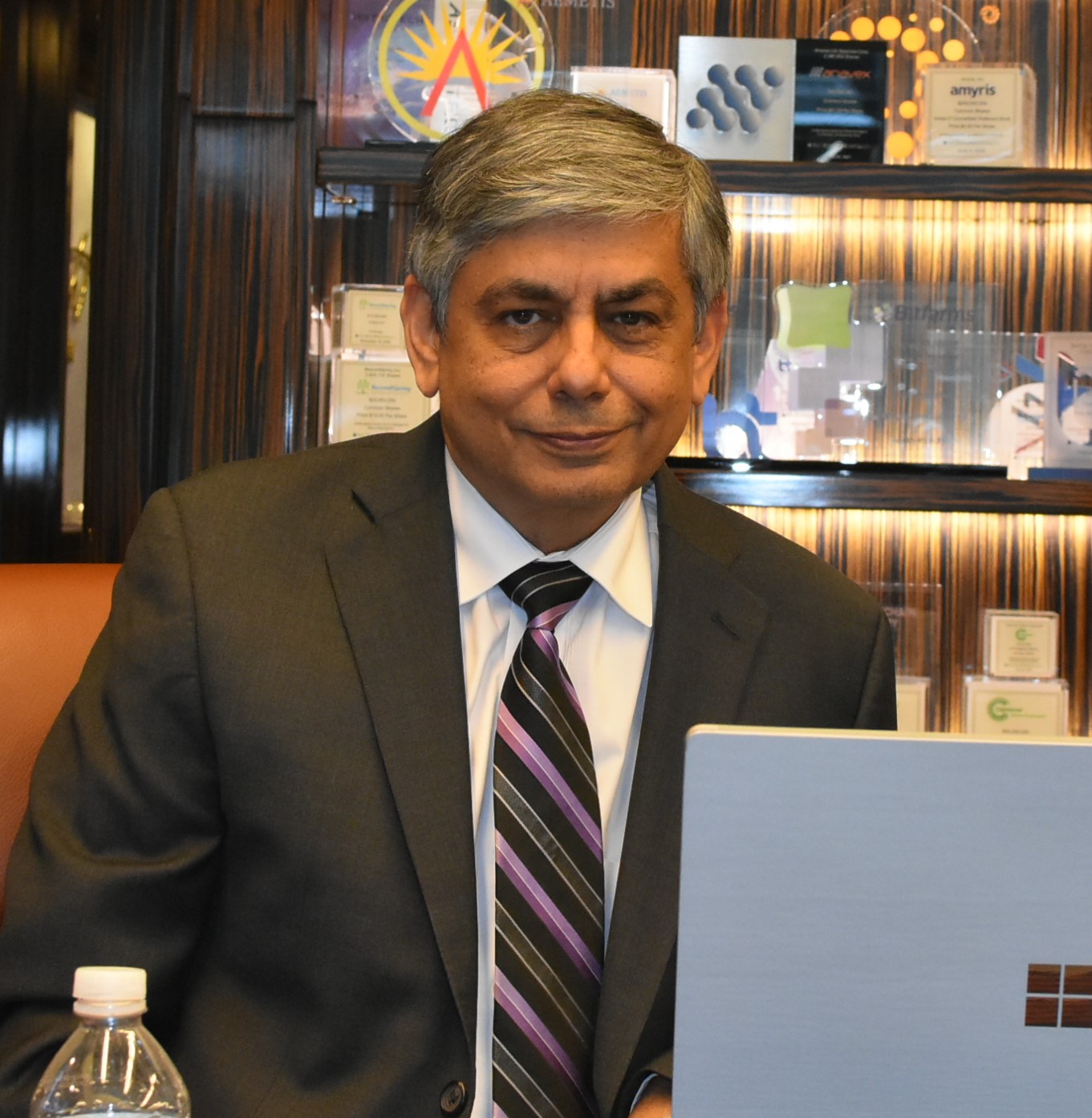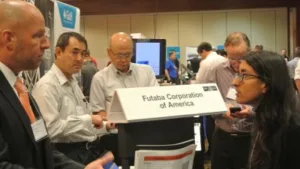On October 29 in a conference room on New York City’s Park Avenue, eMagin Corp. (Hopewell Junction, New York) demonstrated the world’s first full-color OLED microdisplay with a luminance greater than 10,000 cd/m² (Fig. 1) to a small group of journalists and analysts. Several European analysts participated via Zoom.

Fig. 1 The 10,000-nit display viewed through a magnifier. The edge distortion is due to the magnifier. (Photo: Ken Werner) (Click for higher resolution)
The prototype has 1920×1200 pixels (WUXGA). The display diagonal is 0.87 inches (22.1mm), which yields a pixel pitch of 9.6µ and a pixel density of 2645 ppi at high fill factor. This compares to a typical smartphone pixel density of slightly less than 600 ppi. eMagin executives said the key to this achievement was a full-color patterning technology the company calls dPd (Direct Patterning Display), which makes a color filter unnecessary and significantly improves display luminance. dPd is a lithographic printing process developed in-house. eMagin CEO Andrew Sculley said the company intends to make a 28,000-nit color display by 2023. Sculley went on to say that eMagin is working with a ‘Tier One’ consumer company to further develop the technology and to manufacture the displays at commercial scale.
eMagin’s current customers are primarily makers of military, medical, and industrial AR./VR headsets, thermal scopes, night vision goggles, aircraft helmets, and similar applications. A generation of OLED microdisplays based on the current prototype would appeal strongly to these customers. The U.S. government agrees, and has provided almost $40 million in support for technology development and equipment purchases.
At the introduction Amal Ghosh, leader of the team that developed the display, said the production display will have a fill factor of 70%, compared to a fill factor of about 20% for a typical smartphone OLED display with a pentile sub-pixel pattern (Fig. 2).
 The pixel density and fill factor of the new OLED microdisplay (right) are much greater than those of a typical OLED cell phone display (left). (Photos: eMagin Corp.)
The pixel density and fill factor of the new OLED microdisplay (right) are much greater than those of a typical OLED cell phone display (left). (Photos: eMagin Corp.)
One of the analysts asked if the dPd process is done at wafer scale. Sculley answered “yes”. eMagin patterns the entire wafer, and does not do it display by display.
Steve Atwood, Executive Editor of Information Display Magazine, asked about color gamut and gray levels. Olivier Prache, eMagin SVP of Product Development, said that the current prototype has 8 bits of gray level per channel but can go to 10 bits, and that 10 bits has been validated on the larger 4000-nit display that was also being demonstrated. Amal Ghosh added that their current standard products have a color gamut of 97% DCI-P3, but the demonstration products have not yet been measured.
Bob O’Brien, co-founder, principal analyst, and CFO of Display Supply Chain Consultants, asked if the individual OLED structures incorporated microcavities. Amal Ghosh replied that the current displays do not, but incorporating “mild” microcavities would narrow the viewing cone and improve brightness within the cone of light emission.
 Amal Ghosh, leader of the team that created the displays, at the New York conference room on October 29, 2021. (Photo: Ken Werner)
Amal Ghosh, leader of the team that created the displays, at the New York conference room on October 29, 2021. (Photo: Ken Werner)
I mentioned two paragraphs ago that a second display was demonstrated at the event. This was a much larger (2.1-inch) dPd color OLED microdisplay with similar pixel pitch and density, but with a luminance of “only” 4000 nits.
World’s Brightest
“World’s brightest” is a story that any technology analyst would find hard to resist, but there is much more to this. Consumer, and even industrial, headsets suffer from insufficient luminance and pixel density, and a display like the the 10 K-nit OLED can vastly improve some existing applications and make new ones feasible. When the price comes to consumer levels, AR, VR, and gaming headsets will become much more functional and appealing.
Beyond that, eMagin’s lithographic deposition technology is something I would like to learn much more about. I’m looking forward to a tour of the Hopewell Junction plant when eMagin is ready to share this. And I will share what I see with you. (KW)
Note that this article will not count towards your free article allowance.
Ken Werner is Principal of Nutmeg Consultants. He consults on display issues for attorneys, investment analysts, and companies re-positioning themselves within the display industry or using displays in their products. He is the 2017 recipient of the Society for Information Display’s Lewis and Beatrice Winner Award. You can reach him at [email protected].
eMagin CEO Andrew Sculley (left, looking at Amal Ghosh’s computer screen) and SVP of Product Development Olivier Prache (right) at the meeting. (Photo: Ken Werner)

